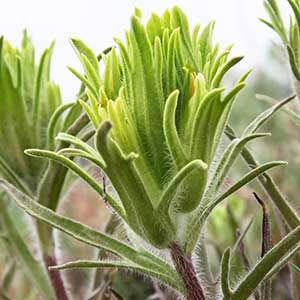Castilleja lineata
Castilleja oresbia
linear-lobed paintbrush, lineated paintbrush, marsh-meadow Indian paintbrush
pale paintbrush, pale Wallowa Indian paintbrush, pale Wallowa paintbrush
few to many, erect or strongly ascending, unbranched except for small, leafy axillary shoots, hairs spreading-reflexed to ± appressed, matted, long, soft, with much shorter stipitate-glandular ones, white-woolly.
few to several, erect or ascending, sometimes decumbent at base, unbranched or branched, hairs usually retrorse, medium length, ± soft, eglandular, mixed with very short-glandular ones, sometimes with spreading, long, soft ones.
green, linear to narrowly oblong or narrowly lanceolate, 1.3–5 cm, not fleshy, margins plane, sometimes wavy, involute, 3–7-lobed, apex acute;
lobes divergent, spreading-ascending, linear, apex acute to acuminate.
green to purple, linear to lanceolate, 2–7 cm, not fleshy, margins plane, involute, 3–5(–7)-lobed, apex acuminate to acute;
lobes spreading, linear to sometimes narrowly lanceolate, apex acute.
5–22 × 1–4.5 cm;
bracts green to yellow-green throughout, or proximally green to yellow-green, distally yellow to sometimes pale yellow-orange, narrowly lanceolate to narrowly oblong or broadly lanceolate, 3(–7)-lobed;
lobes ascending to spreading, linear to oblong, medium length to long, arising near or below mid length, central lobe apex rounded to obtuse, lateral ones acute.
2.5–18 × 1–3.5 cm;
bracts pale green to yellow-green or pale, dull reddish brown throughout, or proximally so colored but changing gradually to cream or yellowish on distal margins, narrowly to broadly lanceolate, (3–)5–7(–9)-lobed;
lobes ascending, linear, long, proximal lobes arising below mid length, central lobe apex obtuse, others acute.
straight or slightly curved, 14–22 mm;
tube 7–14 mm;
beak tip barely exserted from calyx;
beak adaxially greenish, 4–7 mm;
abaxial lip green to yellow, reduced, 1–4 mm, usually less than 67% as long as beak;
teeth erect, white to yellow, 1–2.5 mm.
straight, 21–36 mm;
tube 16–20 mm;
teeth of abaxial lip often exserted, beak exserted;
beak adaxially green, 4.2–5.5 mm;
abaxial lip green to purple, distally white, conspicuous, slightly but noticeably pouched, often visible through front cleft, 3–5 mm, 67–100% as long as beak, puberulent;
teeth erect, white, 1.8–2.1 mm.
colored as bracts, 15–20 mm;
abaxial and adaxial clefts 5.5–8 mm, 30–50% of calyx length, ± deeper than laterals, sometimes appearing subequal in pressed specimens, lateral 5–6 mm, ca. 33% of calyx length;
lobes linear to narrowly lanceolate, sometimes expanded towards apices, apex acute.
colored as bracts, 10–25 mm;
abaxial and adaxial clefts 6–7 mm, 30–60% of calyx length, deeper than laterals, lateral 5–10 mm, 40–50% of calyx length;
lobes linear, apex acute.
= 24.
Castilleja lineata
Castilleja oresbia
Castilleja lineata is restricted to the mountains of northeastern Arizona, southern Colorado, and northwestern New Mexico. It is uncommon throughout its range and is without apparent close relatives. The Navajo used C. lineata as a medicinal plant and for its sweet nectar (D. E. Moerman 1998).
(Discussion copyrighted by Flora of North America; reprinted with permission.)
Castilleja oresbia is endemic to eastern Oregon and adjacent Idaho. It is easily confused with both varieties of C. pallescens, which also occur in sagebrush habitats. Castilleja oresbia has longer calyx lobes and softer pubescence than C. pallescens var. pallescens, although some transitional specimens are found. Castilleja oresbia has a combination of longer calyx lobes, longer pubescence, and obscurely nerved bracts, which usually serve to separate it from C. pallescens var. inverta. All three have different, though somewhat overlapping, ranges. Castilleja oresbia occasionally hybridizes with C. peckiana in Grant County, Oregon.
(Discussion copyrighted by Flora of North America; reprinted with permission.)


